2022 Nininger Travel Award recipients announced
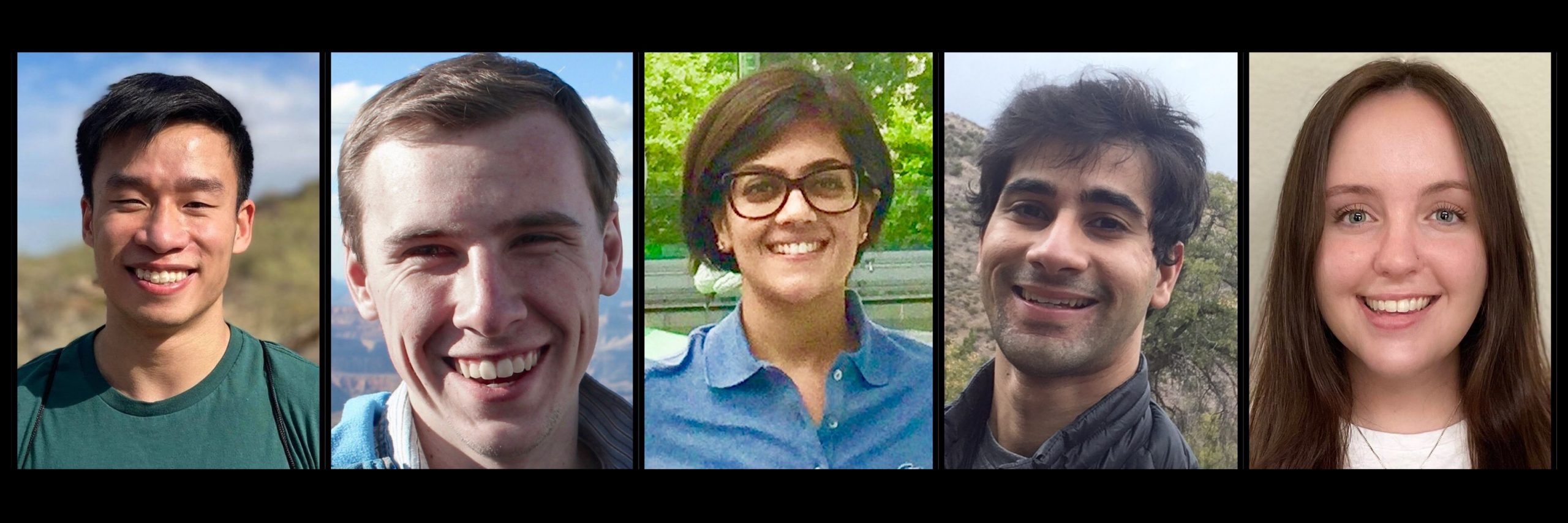 The Buseck Center for Meteorite Studies and the School of Earth and Space Exploration (SESE) are pleased to announce the winners of the 2022 Nininger Student Travel Award. The goal of this award is to support attendance of the annual Lunar and Planetary Science Conference (LPSC) for at least 4 SESE undergraduate and/or graduate students to present their latest research.
The Buseck Center for Meteorite Studies and the School of Earth and Space Exploration (SESE) are pleased to announce the winners of the 2022 Nininger Student Travel Award. The goal of this award is to support attendance of the annual Lunar and Planetary Science Conference (LPSC) for at least 4 SESE undergraduate and/or graduate students to present their latest research.
The awardees are:
Samuel Courville
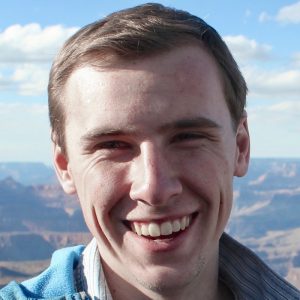 Samuel Courville is a PhD student in the School of Earth and Space Exploration working with Assistant Professor Joseph O'Rourke. Sam is studying how asteroids and planets formed at the dawn of the Solar System. He connects spacecraft observations of asteroids to mineralogy data from meteorites and theoretical astrophysical models of the early Solar System. At LPSC, Sam will demonstrate that two large non-metallic C-type asteroids, 10 Hygiea and 24 Themis, could have magnetic fields as a byproduct of forming in the solar nebula. This is an important result because it is a testable prediction of asteroid formation theories. He will argue at LPSC that sending a magnetometer to these asteroids would be a way to test if our understanding of their formation is correct. Read Samuel's LPSC abstract, here!
Samuel Courville is a PhD student in the School of Earth and Space Exploration working with Assistant Professor Joseph O'Rourke. Sam is studying how asteroids and planets formed at the dawn of the Solar System. He connects spacecraft observations of asteroids to mineralogy data from meteorites and theoretical astrophysical models of the early Solar System. At LPSC, Sam will demonstrate that two large non-metallic C-type asteroids, 10 Hygiea and 24 Themis, could have magnetic fields as a byproduct of forming in the solar nebula. This is an important result because it is a testable prediction of asteroid formation theories. He will argue at LPSC that sending a magnetometer to these asteroids would be a way to test if our understanding of their formation is correct. Read Samuel's LPSC abstract, here!
Andrea Distel
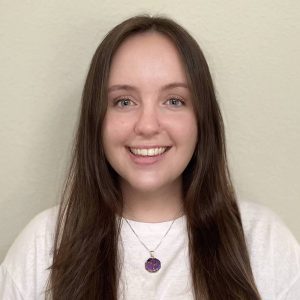 Andrea Distel is a 1st year PhD student in the School of Earth and Space Exploration working with Drs. Rick Hervig, Jemma Davidson, and Meenakshi Wadhwa. Her research focuses on measuring trace hydrogen in nominally anhydrous minerals (NAMs) in the Secondary Ion Mass Spectrometry (SIMS) lab at ASU. Specifically, she studies trace hydrogen in minerals from lunar samples, and works on improving SIMS analyses for this element in NAMs. At LPSC, Andrea will present a fresh perspective on analytical procedures and selection of standards for SIMS analyses of hydrogen in NAMs. This research provides information to the SIMS community conducting these measurements on how to improve these analyses, which is an area of active debate and research. Read Andrea's LPSC abstract, here!
Andrea Distel is a 1st year PhD student in the School of Earth and Space Exploration working with Drs. Rick Hervig, Jemma Davidson, and Meenakshi Wadhwa. Her research focuses on measuring trace hydrogen in nominally anhydrous minerals (NAMs) in the Secondary Ion Mass Spectrometry (SIMS) lab at ASU. Specifically, she studies trace hydrogen in minerals from lunar samples, and works on improving SIMS analyses for this element in NAMs. At LPSC, Andrea will present a fresh perspective on analytical procedures and selection of standards for SIMS analyses of hydrogen in NAMs. This research provides information to the SIMS community conducting these measurements on how to improve these analyses, which is an area of active debate and research. Read Andrea's LPSC abstract, here!
Aditya Khuller
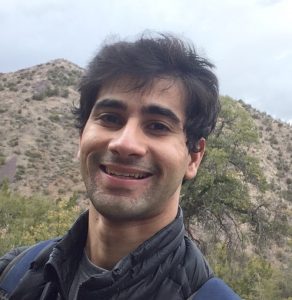 Aditya Khuller is a 3rd year PhD student in the School of Earth and Space Exploration working under Dr. Phil Christensen. His research focuses on studying ices (H2O and CO2) on Mars. In particular, he is studying whether ice is melting on Mars today, after noticing that ice exposed at the surface in the martian mid-latitudes was disappearing after a few years. Because turbulence and solar radiation are the two biggest contributors to ice melting, at LPSC, he will be presenting results of an atmospheric turbulence model he has been developing with co-author Gary Clow. This model simulates the energy lost to the atmosphere by ice on Mars. The results from this model were validated against in-situ measurements of ice at Mars during the Phoenix lander mission in 2008. He will combine these results with his past solar radiation modeling to assess whether ice is melting on Mars today. If the ice is indeed melting, then the presence of this near-surface liquid water would have compelling implications for potential past or extant life, and the future of robotic and human exploration on Mars. Read Aditya's LPSC abstract, here!
Aditya Khuller is a 3rd year PhD student in the School of Earth and Space Exploration working under Dr. Phil Christensen. His research focuses on studying ices (H2O and CO2) on Mars. In particular, he is studying whether ice is melting on Mars today, after noticing that ice exposed at the surface in the martian mid-latitudes was disappearing after a few years. Because turbulence and solar radiation are the two biggest contributors to ice melting, at LPSC, he will be presenting results of an atmospheric turbulence model he has been developing with co-author Gary Clow. This model simulates the energy lost to the atmosphere by ice on Mars. The results from this model were validated against in-situ measurements of ice at Mars during the Phoenix lander mission in 2008. He will combine these results with his past solar radiation modeling to assess whether ice is melting on Mars today. If the ice is indeed melting, then the presence of this near-surface liquid water would have compelling implications for potential past or extant life, and the future of robotic and human exploration on Mars. Read Aditya's LPSC abstract, here!
Srinidhi Ravi
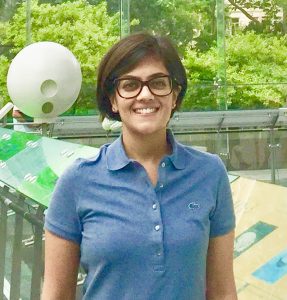 Srinidhi Ravi is a 5th year PhD candidate in the School of Earth and Space Exploration working with Professor Mark Robinson. Her research focuses on the lithospheric evolution of the lunar Procellarum KREEP (potassium (K), rare earth elements (REE), and phosphorus (P)) Terrane (PKT). The PKT hosts the largest population of floor-fractured craters, which are impact craters that underwent subsequent modification due to volcano-tectonic processes and, as a result, these landforms serve as time capsules for local and regional lithospheric deformation in early lunar history. At LPSC, Srinidhi will present preliminary results on lithospheric strength envelopes on the Moon at 4 Ga. The results confirm that the rheology of anorthosite coupled with the spatial distribution of floor-fractured craters are in fact favorable for viscous relaxation early lunar geologic history. Read Srinidhi's LPSC abstract, here!
Srinidhi Ravi is a 5th year PhD candidate in the School of Earth and Space Exploration working with Professor Mark Robinson. Her research focuses on the lithospheric evolution of the lunar Procellarum KREEP (potassium (K), rare earth elements (REE), and phosphorus (P)) Terrane (PKT). The PKT hosts the largest population of floor-fractured craters, which are impact craters that underwent subsequent modification due to volcano-tectonic processes and, as a result, these landforms serve as time capsules for local and regional lithospheric deformation in early lunar history. At LPSC, Srinidhi will present preliminary results on lithospheric strength envelopes on the Moon at 4 Ga. The results confirm that the rheology of anorthosite coupled with the spatial distribution of floor-fractured craters are in fact favorable for viscous relaxation early lunar geologic history. Read Srinidhi's LPSC abstract, here!
Kevin Trinh
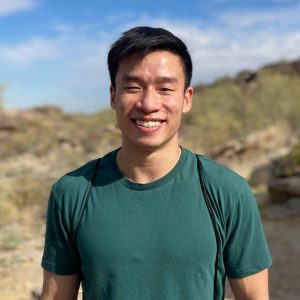 Kevin Trinh is a 2nd year PhD student in the School of Earth and Space Exploration who is primarily interested in the formation, evolution, and potential habitability of icy moons. At LPSC, Kevin will explore one key question: When did Europa start forming its metallic core? Previous models typically assume that Europa formed its metallic core immediately or shortly after accretion. However, the timing of Europa's metallic core formation has profound implications for Europa's thermal evolution, magnetic history, and subsurface ocean habitability. Using a parameterized thermal evolution model, Kevin argues that Europa may have spent most of its life without a fully formed metallic core. This work was done in collaboration with Kevin's advisor, Assistant Professor Joe O'Rourke, and with Postdoctoral Fellow Carver Bierson. Read Kevin's LPSC abstract, here!
Kevin Trinh is a 2nd year PhD student in the School of Earth and Space Exploration who is primarily interested in the formation, evolution, and potential habitability of icy moons. At LPSC, Kevin will explore one key question: When did Europa start forming its metallic core? Previous models typically assume that Europa formed its metallic core immediately or shortly after accretion. However, the timing of Europa's metallic core formation has profound implications for Europa's thermal evolution, magnetic history, and subsurface ocean habitability. Using a parameterized thermal evolution model, Kevin argues that Europa may have spent most of its life without a fully formed metallic core. This work was done in collaboration with Kevin's advisor, Assistant Professor Joe O'Rourke, and with Postdoctoral Fellow Carver Bierson. Read Kevin's LPSC abstract, here!